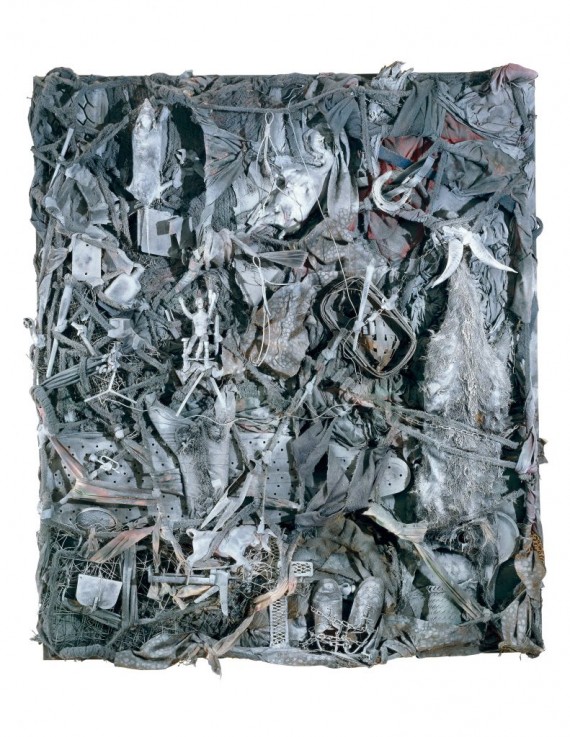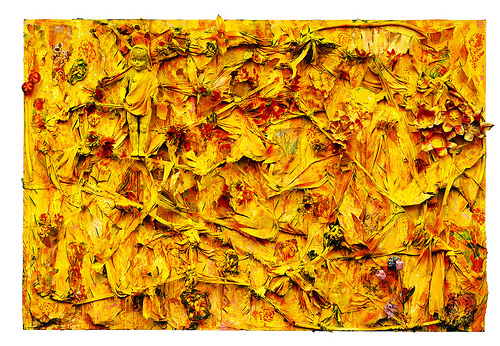The goat is probably the wrong place to start a discussion of Thornton Dial‘s art, but how often does a spray-painted silver goat show up on the walls of NOMA? There’s clearly a dessicated goat – as the list of materials for the piece “Lost Farm (Billy Goat Hill)” refers to it – incorporated into the work, along with an ironing board, tire scraps, pieces of a peach basket, toys and more. That partial list of found objects incorporated into Dial’s piece is misleading, though. It makes the piece sound whimsical or nutty, and little in “Hard Truths: The Art of Thornton Dial” is light-hearted.
Dial is a self-taught African-American artist from rural Alabama, and at the most immediate level, his works stand on their own as bold, abstract compositions – primarily large canvases, but there are also a handful of sculptures and drawings included in the retrospective of Dial’s 20 years making art that was organized by curator Joanne Cubbs for the Indianapolis Museum of Art. He is now in his 80s, so it’s no surprise that the issues that connect to race and class in America are addressed in his art. The materials aren’t simply bits of trash; they’re evidence of his existence collected and assembled to speak in complex ways to the social, political, spiritual and physical world he’s walked through.
“Lost Farm (Billy Goat Hill)” will resonate with New Orleanians because it looks like it was dusted with the gray residue that was left behind when the post-Katrina floodwaters receded, and a level of grime is common to the finish of many of the pieces in the show. The dominant colors of pieces change, but there is an earthy, worn character to Dial’s work, and like waterlines and the grime here, it suggests both struggle and survival.
In writer Greg Tate’s essay in the show’s catalogue, he connects Dial and jazz composer Sun Ra. Both were born in Alabama, and “in the 1960s and ’70s, many of us who love and admire Dial’s work today were decades away from becoming aware that Alabama was a place full of visually visionary Black American fabulists,” Tate writes. “Nor did we know that Ra’s Alabama-born painting and sculpting brethren and sistren, such as Dial, made spectacular and sardonically signifyin’ works of art that likewise delineated the crossroads of earthly and extraterrestrial existence and African American politics and mysticism.”
Like Ra’s work, Dial’s art speaks in a personal voice that requires its audience to engage it in multiple ways. The abstract design suggests big picture thoughts – anger, struggle, harmony, acceptance – but if only engaged as design, much is lost. Similarly, treating his canvases as assemblages of cast-off articles turns the pieces into a game of “I Spy” and the gravity is lost. One piece has a series of numbered tops for spray paint cans, a ruler and a TV antenna, but you don’t need the title – “Strange Fruit: Channel 42” – to see the lynching theme.
It’s easy to imagine Dial’s work as improvised, formed by the found objects his mood settled on, and a Jackson Pollock-like layering of materials until a design emerges. Like Pollock, Dial’s work needs to be seen in person to be fully appreciated. The physical richness and texture of both artists’ canvases are lost in photos, but the drawings in the middle of Dial’s show suggest that at some point fairly early in the process, his compositional sense became more deliberate than the materials might suggest. The drawings have charms in their own right as well, particularly his drawing of the World Trade Center on 9/11 – a depiction of falling rubble that suggests action without seeming hurried.
As serious as Dial’s work can be, it’s not humorless nor relentlessly grim. Dolls and toys turn up throughout the show, some as stand-ins for damaged innocence, and some for playful effect. “Setting the Table” is literally a tablescape rendered in thick brush strokes and bright colors with a pile of purple beads standing in for grapes, a yellow bag representing a bunch of bananas, and a pot on the piece has split hard-boiled eggs painted on its inside. A sculpture titled “The Art of Alabama” features a tower of brightly colored rags and bits of pipe looming over a concrete lawn statue of a Grecian figure painted yellow and resting atop a wooden crate, and it invites thoughts about relationship between class and culture in Alabama – what passes for it, and how it’s treated.
“The Beginning of Life in the Yellow Jungle” employs a similar straight-faced wit when Dial manipulates the bottom of a plastic soda bottle two or three different ways, each in some way remade to resemble a flower. The piece is a study in yellow, but not so much so that Dial allows the component parts to lose their integrity. The yellow spray paint doesn’t entirely hide the image of a snarling lion or the floral print on a sheet. Everything has value, his work seems to say, and given the context of his work, it’s not a reach to extend that thought to people as well as things. In his art, Dial recognizes the value of discarded objects and makes them figuratively (and literally, since his work became collectible) valuable.
Too often with self-taught artists, the drama is centered on the artist, not the art. The questions prompted by the work have less to do with what he or she is doing and more to do with why it would seem like a good idea to anyone. That’s not the case in “Hard Truths.” Dial’s work speaks eloquently if idiosyncratically, expressing a broader emotional palate that many self-taught artists can access. You can see him discover for himself numerous 20th Century art movements in the process of assembling the world around him as a way of speaking to that world, which lends credence to one of the underlying impulses behind the show – to argue for Dial’s place in American “high art” canon. The point’s made fairly quickly at NOMA. The difference between Dial’s work and the pieces from the museum’s self-taught artist collection that are hung in NOMA’s Great Hall is clear. His materials may be common, but his work is sophisticated.
[youtube]http://www.youtube.com/watch?v=7Np0BoXmKOg[/youtube]
“Hard Truths: The Art of Thornton Dial” is on display now at NOMA. On March 2, curator Joanne Cubbs will lead a walk-through of the show at 6:45 p.m. On March 30 at 6:30 p.m., artist Shawne Major will lead a walk-through, and artist Willie Birch will lead a walk-through of the show on April 20 at 6 p.m. The museum will host a discussion of modern folk art May 18 at 6 p.m.






